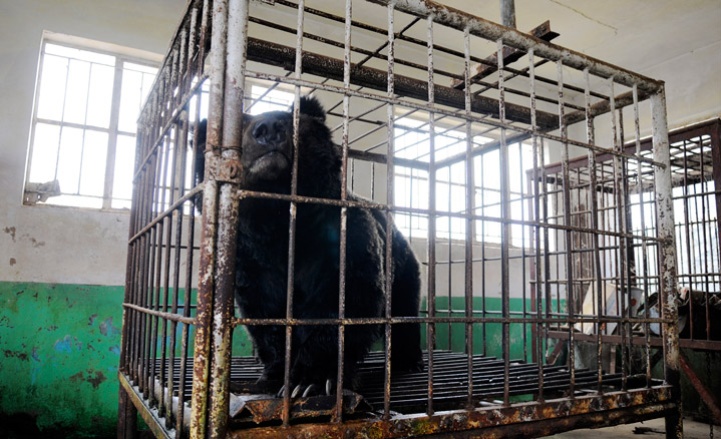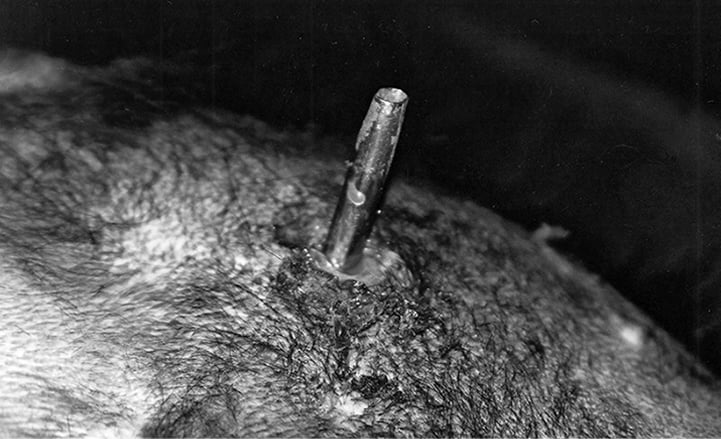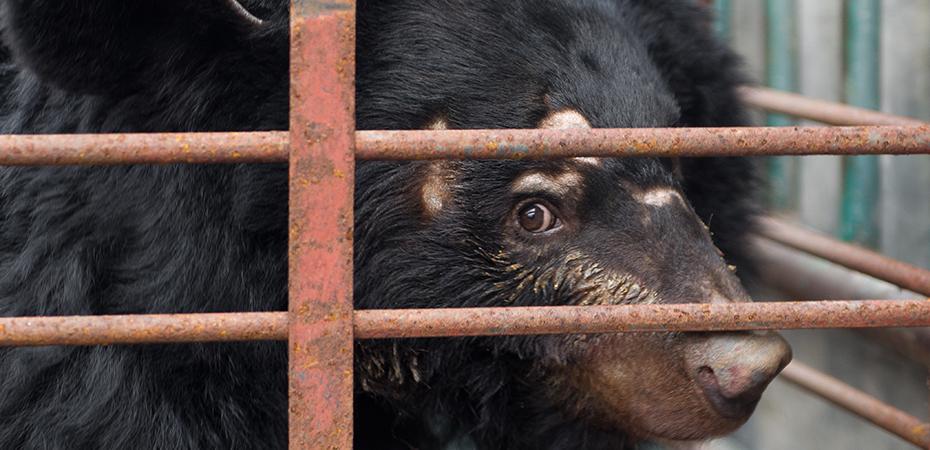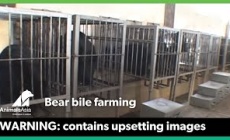In China and Vietnam, where we focus our work to end bear bile farming, over 12,000 bears – mainly moon bears but also others such as sun bears and brown bears – are held in captivity on farms and “milked” regularly for their bile, which is used in traditional medicine.
Most farmed bears are kept in tiny cages. In China, the cages are sometimes so small that the bears are unable to turn around or stand on all fours. Some bears are put into cages as cubs and never leave them. They may grow too large to fit through the cage door or, as in the case of Franzi remain stunted and tiny because they simply have no room to grow. Bears may be kept caged like this for up to 30 years. This has a terrible effect on the physical and mental well-being.
The bile, which is stored in the gall bladder, is collected by means of various extraction methods, all of which cause massive infections in the bears. Most farmed bears are starved, dehydrated and suffering from multiple diseases and malignant tumours that not only contaminate their bile but ultimately kill them. Very few receive appropriate medication or any type of veterinary care. Animals Asia has also seen instances of old or very sick bears – those who fail to produce bile – simply left to starve to death in their cages.
Pathology reports have shown that bile from sick bears is often contaminated with, blood, pus, faeces, urine, bacteria and cancer cells.
Despite the availability of inexpensive and effective herbal and synthetic alternatives – and the dangers of consuming bile from sick bears – bile farming continues.
Demand for bear bile products comes mainly from China, Japan, Korea, Vietnam, Malaysia and Taiwan. Bear bile products are also found in Australia, Indonesia, Laos, Myanmar, Singapore, the US and Canada.
Although bear bile has been used in traditional medicines for thousands of years, bear farming as an industry first began in China in the early 1980s. Adopting procedures developed in North Korea to extract bile from living bears, entrepreneurs began caging moon bears and milking them daily for their bile.
The Chinese government claimed that farming bears in this way would satisfy local demand for bile while helping to conserve the country’s wild populations of Asiatic black bears by reducing the number of bears killed in the wild for their gall bladders and other body parts. However, the growth in the bear farming industry has led to the increased commercialisation of, and demand for, bear bile products and wild bears continue to be killed illegally due to the perceived higher value of bile extracted from a wild animal. Wild bears are also poached as an illegal source of new stock for farms.
In China
All species of wild bear are protected by law in China but bear farming and the use of bear bile is legal. Although many farms claim to breed their own bears, many of the bears arriving at our China sanctuary are missing limbs – probably as a result of having been caught in the wild in snares or other traps.
According to official figures released in 2007, there were 7,002 bears kept on 68 farms. However, research conducted by Animals Asia suggests there are at least 97 farms, including illegal facilities, holding over 10,000 bears. We estimate that between 5,000–6,000 workers are employed on Chinese bear bile farms.
Chinese bear bile farms tend to operate on a relatively large scale – with the largest holding over 2,000 bears. These large farms are typically owned by major pharmaceutical companies.
Although regulations on minimum cage sizes, access to outdoor enclosures and permissible extraction methods exist to control bear bile farming and “protect” farmed bears these regulations are rarely followed or enforced. Through our rescue work, Animals Asia has witnessed bears kept permanently immobile in cages that are barely the size of their body, as well as evidence of the use of condemned extraction methods such as metal jackets and catheter implantations.
“In April 2010, Animals Asia rescued ten bears from a farm in Shandong, many of whom had clearly had their metal jackets removed shortly before our arrival.”
The main provinces for bear bile farming are Heilongjiang and Jilin in the north and Sichuan and Yunnan in the southwest. The northern areas see large numbers of tourists from Korea, who also visit the farms and buy bear bile products to take home. As all cross-border trade in bear products is banned by CITES (unless special permission has been granted), we are working to reduce this practice.
In Vietnam
Although bear farming, hunting and the trade in bear parts and bile products are all illegal in Vietnam, it is permitted to keep bears as “pets” and to display them to tourists – a loophole that many farmers are known to exploit. While most bear “owners” claim that their bears do not have their bile extracted, bear farming and the sale of bear bile products is a thriving industry.
In “Moon Bears: The Hidden Truth”, director Martin Guinness uncovers the secret world of illegal bear farming in Vietnam. The documentary is Guinness’s companion film to “Cages of Shame”, an exposé on bear farming in China.
Official government figures indicated that there were 1,453 bear farmers in the country in 2005, and show a gradual decline in the number of farmed bears from 4,190 in 2005 to around 3,500 in 2009. The most recent government estimate puts the number of bears at around 1,200. Many farms in Vietnam are small, family-owned enterprises, with some families or companies owning a single bear and extracting bile occasionally.
The highest concentration of bear farms is in the north, around Hanoi, Hai Phong, and Ha Long in Quang Ninh Province – an area that sees large numbers of tourists from China, Korea and Taiwan*. Some of the farms in this area are also larger in size. Many tour operators to the area offer visits to bear farms that include live bile extractions and the possibility to buy bear bile products.
*UPDATE: Following international pressure, it was announced in April 2015 that the Halong Bay bears could be rescued by Animals Asia. In addition, the local authorities of Vietnam’s Quang Ninh government agreed to completely end bear bile farming in the province by transferring all of the remaining 38 bears to Animals Asia’s Vietnam Bear Rescue Centre. The rescues took place over the summer months in 2015.
In Vietnam, moon bears and Malayan sun bears are both farmed. Under Vietnam’s Ministerial Decree 32, both of these species are listed in category 1B (critically endangered) and are legally protected. However, due to a lack of law enforcement resources, bears continue to be captured for the bile farming industry or killed for their meat and body parts. Every year, Animals Asia rescues wild-caught cubs, confiscated from smugglers en route to farms in Vietnam and neighbouring countries such as Laos and China.

A latex catheter is surgically implanted into the bear’s abdominal wall and gall bladder.
In some instances, the catheter is surgically embedded under the skin from the abdomen to the hip, where it exits and enables the farmer to extract the bile at a safe distance from the bear’s head.
This method allows 50–100ml of bile to be tapped from each bear twice daily, but is liable to clogging as the bile crystallises.
Although against regulations in China, evidence of this method is commonly seen in bears at our Chengdu sanctuary.
A rubber pipe is surgically connected to the bear’s gall bladder and attached to a fluid bag inside a metal box. To hold the box in place against the bear’s abdomen, the bear is fitted with a metal jacket weighing more than 10kg.
Bile is emptied from the bag about every two weeks.
To drain the bile bag, the farmer must crawl under the bear’s cage to unlock the metal box. Bears wearing metal jackets often suffer from infection, hair loss and skin irritations. Oliver (pictured above), who had possibly worn a metal jacket for 30 years, was in such a poor condition when rescued in April 2010 that emergency surgery had to be performed on him during the journey to our sanctuary.
Although against regulations in China, evidence of this method is seen in bears at our Chengdu sanctuary.
“Brown bear Oliver had been fitted with a metal jacket that was removed shortly before our arrival – a metal wire remained protruding from his abdomen."
A 5–7 inch metal catheter is surgically implanted into the abdominal wall and gall bladder, allowing daily extraction of the bile.
Bears extracted in this way are often kept in “crush cages” which have a metal grille that can be pushed down to immobilise the bear against the bottom of the cage, allowing the farm worker to collect the bile through the bars.
In many instances, farmers keep the metal grille in the crush position indefinitely – sometimes for years – forcing the bear to endure a living hell, unable to move for years on end.
This was the case for Jasper (pictured above), who was rescued from such a cage and went on to spend 15 joyful years living happily at our centre in Chengdu.
As these catheters are embedded permanently, they often begin to rust and decompose within the bear’s body.
Although against regulations in China, evidence of this method is seen in bears at our Chengdu sanctuary.
“Jasper had spent 15 years of his life confined in a crush cage barely the size of his body.”
Bears undergo one-off surgery to create a permanently “open” duct or fistula from the gall bladder to the abdomen. Bile drips freely from this duct.
As the hole naturally tries to heal itself, each milking session involves poking a metal tube through the membrane that has grown over the wound to allow the bile to flow out.
Although this method is claimed to be the most “humane”, more than 20 per cent of rescued free-drip bears have infected fistulas and abdominal abscesses. Some have peritonitis caused by bile leaking into the abdomen. Bile collected in this way is also observed to contain pus and other contaminants.
This method is the only extraction method currently permitted in China and is commonly used on Chinese farms.
To prevent the free-drip hole from healing, an “invisible”, clear, perspex catheter is inserted intothe fistula and cut flush with the surface of the abdomen.
Although against regulations in China evidence of this method is seen in bears at our Chengdu sanctuary.

Bile is extracted directly from the bear’s gall bladder by means of a temporary catheter and pump or a syringe. After the bear has been drugged with ketamine, its gall bladder is located (by means of an ultrasound or by repeated “blindpuncturing” attempts with a needle) and the bile is extracted using a catheter and pump or a syringe. Around 80–100ml of bile is extracted from each bear each time.
This method is common in Vietnam.
Bile is removed from the gall bladder by means of major abdominal surgery.
This surgery could be performed only every three months. Many bears generally survived only four such surgeries before dying from infections caused by crude and unhygienic surgery conditions.
This method is believed to have been phased out in the early 2000s.






